| Jun-09-10 | | jerseybob: What a great gritty game from Bernstein, and one reason for Reshevsky's poor start in this tourney. I don't know this line well, but I don't see the need for wasting a move with 6.a3. Wouldn't 6.Bd3 with development have been better? As played, after 8.Qxc3(bxc3!?) black has a queenside bind that he never relinquishes. |
|
| Jun-10-10 | | syracrophy: 42.♔g4 ♕h5+! 43.♔g3 ♕xf3+ 44.♔h2 ♕e2+ and curtains down... |
|
| Jun-16-10 | | jerseybob: After 42.Kg4,Qh5ch?? 43.Kxh5 what does black have? There's no fork. The correct way is 42..h5ch 43.Kg5,Nxf3ch |
|
| Jul-01-10 | | syracrophy: <jerseybob> Oh, damn! LOL You're right! I saw wrong the board, imagining there was a fork somewhere. Thanks for correcting my mistake (: |
|
Jun-23-12
 | | Phony Benoni: <jerseybob> Maybe Reshevsky was taking Fine's word for it, since the latter played 6.a3 against him in the Western Chamionship at Chicago, 1934. Instead of queenside pressure, Reshevsky played 8...Qe7 and followed by pushing both center pawns, resulting in a short draw. Perhaps Bernstein's 8...Na5 was prepared. |
|
| Jul-13-16 | | Abdel Irada: ∞
<syracrophy: <jerseybob> Oh, damn! LOL You're right! I saw wrong the board, imagining there was a fork somewhere.> Half a fork is better than none. :-D
∞ |
|
| May-01-18 | | morfishine: True bout the fork(s)
What really happens is White is spoon-fed a sound exchange sac before Black drives the knife home |
|
| Oct-30-18 | | goser: White had decisive advantage but turned their position from winning to lost by just one move - 36. Rd1?? instead of 36. Qc3. |
|
| Oct-31-18 | | Count Wedgemore: <goser> Or he could have played 36.Re8+ first, then Qc3. That looks even better. 36.Rd1 was a real howler. He must have completely missed Black's ...Nd4. |
|
Jul-13-20
 | | NM JRousselle: 29 Nd5 looks like a crushing move. |
|
| Jan-06-22 | | jerseybob: <NM JRousselle: 29 Nd5 looks like a crushing move.>You're right, and in my original high praise of this game back in 2010, I'm embarrassed to have missed this. I know both Reshevsky and Bernstein missed it too, but that was in the heat of battle. And now that I'm reassessing my praise, let's look at black's 25..Rxb4 26.axb4,Nc4; does black get enough for his exchange sac? It originally seemed to me that he did, but in light of NM Rousselle's discovery of 29.Nd5, does he really? The engine suggests 25..Nb7 which has a nice Nimzovitchean feel. So until the next big hole in my analysis is found, that's the move I'll hang my hat on. |
|
Oct-19-23
 | | KEG: This win by Bernstein over Reshevsky in Round 3 of the 1936 US Championship tournament was shocking. From 1936 until the ascendancy of Bobby Fischer in the 1957-1958 US Championship, this even was dominated by Reshevsky. For part of this time, Reshevsky had formidable rivals, most notably Reuben Fine. Nonetheless, Reshevsky won every such event he entered in the pre-Fischer period except for the 1951 tournament when he finished 2nd a point behind Larry Evans:
(A) In 1938--he took first a half-point ahead of Fine, and was undefeated;
(B) In 1940, he again took first a half-point ahead of Fine and was again undefeated;
(c) In 1942, he played a match for the championship against Horowitz and prevailed without the loss of a single game;
(D) Later in 1942, Reshevsky tied for first place with Isaac Kashdan and was undefeated. He then won a playoff match against Kashdan by the score of 6-2 with three draws.
(E) Reshevsky sat out the 1944 championship (won by Arnold Denker), but then returned in 1946 and again took first (2-and-a-half points ahead of second place Kashdan) and again was undefeated, winning his games against both Kashdan and Denker.
(F) Reshevsky sat out the 1948 championship which was won by Herman Steiner (Reshevsky was playing for the worldcrown that year). He returned to US Championship play in 1951, finishing second by a point to Larry Evans. His sole loss in that tournament (to Ariel Mengarini) provided the margin of victory for Evans (who managed to defeat Mengarini). The loss to Mengarini was the first US Championship tournament loss by Reshevsky since 1936. Going into the initial US Championship in 1936, Reshevsky--despite the strong field which included Fine, Kashdan, Dake, Kevitz, and two future champions (Denker and Steiner)--Reshevsky had to have been the favorite in light of his two extraordinarily impressive tournament victories earlier that year at Syracuse (ahead of Kashdan, Dake, and Fine) and at Margate (a half-point ahead of Capablanca). Reshevsky went undefeated in both of those very strong tournaments. It was therefore incredible that in the 1936 US Championship, Reshevsky, after defeating Morton in the first round and drawing with Simonson (the eventual second-prize winner), lost consecutive games to Bernstein and Horowitz. This was the only game Reshevsky ever lost to Sidney Bernstein, and he pretty much dominated Horowitz for the balance of their respective careers. Even more incredible was the way Reshevsky lost to Bernstein. For most of the game, Reshevsky was on top and he--contrary to what was suggested in Bernstein's commentary--had a won game at the time of his losing blunder on move 36. For once Sammy faltered in time trouble. He became famous for his ability to play fabulous chess with just minutes or seconds left on his clock. But here he lost his way--undoubtedly because of his time trouble. He was then unrecognizable in his 4th round game in which he got thrashed by Horowitz. It is a tribute to Reshevsky's resilience that even after these two disaster he pulled himself together, won nine of his final eleven games with no further losses, and managed to take the crown a half-point ahead of Simonson and a full point ahead of Fine (and Treysman). The game itself was thrilling, and--in light of the result and reversal of fortune--a curiosity. 1. d4 Nf6
2. c4 e6
3. Nc3 Bb4
Bernstein always liked sharp play, hence his choice of the Nimzo-Indian Defense. 4. Qb3
The Spielmann line, a solid though probably not the most testing way to combat the Nimzo. 4... Nc6
I would have expected the sharper and more usual 4...c5 from Bernstein. 5. e3 a5?!
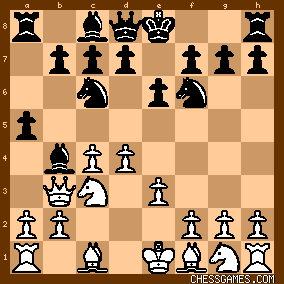
click for larger viewSafer and probably sounder are 5...0-0 or 5...Ne4 or even 5...BxN+. But Reshevsky himself had played the text against Fine two years earlier (a game that was ultimately drawn), and Bernstein may have decided to use Reshevsky's own weapons against him. If that was Bernstein's plan, it initially worked like a charm by by move 10 Bernstein, as will be seen, took advantage of some doubtful early play by Reshevsky and emerged with much the better position from the opening. |
|
Oct-19-23
 | | perfidious: <KEG>, on the opening, 5.e3 is too easygoing and Black gets a comfortable position, if in a different way than after the similar 4.Qc2 Nc6 5.e3 (5.Nf3 is also stronger in this line) e5. |
|
Oct-20-23
 | | KEG: <perfidious>I see nothing wrong with the natural 5. e3. The main alternative was 5. Nf3. But that can easily transpose (e.g., compare 5. Nf3 0-0 6. e3 Ne4 7. Bd3 f5 8. 0-0 with 5. e3 0-0 6. Nf3 Ne4 7. Bd3 f5 8. 0-0). This would all have been different had Reshevsky played 4. Qc2 (as in your line) rather than the potentially more prosaic Spielmann move (4. Qb3). The real problem for Reshevsky in this opening was with the follow up to 5. e3, as I will discuss in my Post II on this game. |
|
Oct-20-23
 | | KEG: Post II
6. a3
Questionable at best. It should have been obvious that Bernstein had 6...a4 in view, so Reshevsky should have focused on rapid development with 6. Nf3 or 6. Bd3 or maybe even 6. Bd2 or 6. Be2. The text allowed Bernstein to obtain a decent position as Black (and Reshevsky's follow-up only made matters worse for White). Getting the two Bishops was Reshevsky's only solace. 6... a4!
Of course.
7. Qc2 BxN+
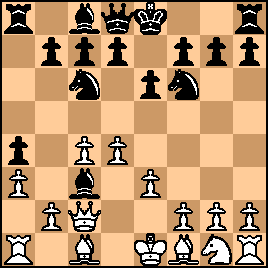
click for larger view8. QxB
Another strange choice by Reshevsky. The Queen was better on c2, and 8. bxB was clearly superior to the text. 8... Na5!
Bernstein took immediate advantage of 8. QxB. After the text, White no longer enjoyed any opening advantage I can discern. And then matters got even worse for Reshevsky: 9. Bd3 d5

click for larger view10. c5?
This locking of the Queen-side pawns made little sense. Reshevsky would not have been much worse for wear with 10. cxd5 of 10. Ne2. But now it was Bernstein's turn to miss an opportunity: 10... 0-0?
Black would have had much the better game with 10...Nb3 or 10...Ne4. But Reshevsky still seemed not to have been following the flow of the position: 11. Ne2
Why not simply 11. Nf3.
11... b6
"!"--(Bernstein)
11...Nb3 or 11...e5 were much stronger. The text left: 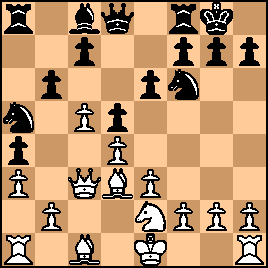
click for larger view12. cxb6 cxb6
13. Qc2 Nb3
Better late than never.
14. Rb1 Ba6
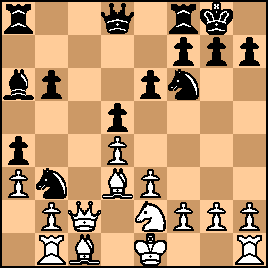
click for larger viewBernstein here commented that he was "elated" at the opportunity to get rid of the d3 White Bishop, and indeed at this point he had a small edge. But Bernstein further noted that, from here, he was "unable to formulate a good follow-up plan." But, as will be seen, for the next several moves Reshevsky erred, and was not able to achieve any advantage--despite Bernstein's inability to capitalize on his slightly superior position: 15. BxB RxB
16. Bd2 Qd7
17. Qd3 Ra7
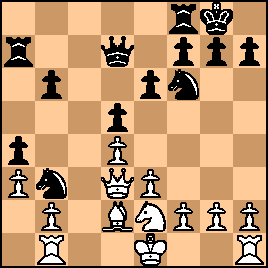
click for larger viewThe sloppy play continued for a while longer before Reshevsky managed to seize control and build a winning position--mainly thanks to some highly doubtful play by Bernstein. |
|
Oct-21-23
 | | KEG: Post III
18. f3
This doubtful move did indeed ultimately allow Reshevsky to play e4, but it created weaknesses with which he would needlessly have to deal. Among other things, it allowed Bernstein to trade off his remaining Bishop.
Simpler and better were 18. Bb4, 18. 0-0, or even 18. Bc3. 18... Rc8
Why not just play 18...NxB. Later on in the game, Bernstein decided to give up his Rook to get rid of this Bishop. He could, instead, have traded it off for a Knight. Most likely, Bernstein, who liked tactics, liked having a Knight on b3. If that was his goal, he did in fact manage to retain this Knight on b3 for another 14 moves. 19. Bc3
Since Reshevsky played 20. Bb4 on his next turn, this 19th move proved to be loss of time. 19... Ne8
Thanks to Reshevsky's dithering, Bernstein now had chances for attack beginning with 20...Nd6. 20. Bb4
Reshevsky decided to submit to having lost time to be prepared for Black's possible Nd6. The position was now:
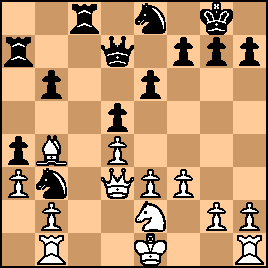
click for larger view20... Rac7
Bernstein, who surely had the better of the position at this point, now seemed to begin to lose the thread of the game. While there was nothing terribly wrong with the text, why not simply 20...Nd6. 21. 0-0 f5?!
"This seemed necessary to dilute the effect of White's advance e4." (Bernstein). In fact, and as Bernstein conceded, the text made no progress in this direction as Reshevsky simply played: 22. e4
"!"--(Bernstein)
So much for that idea of Bernstein. The text left: 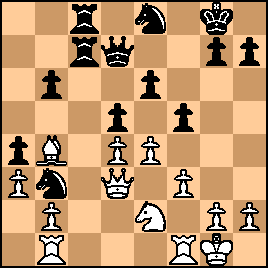
click for larger viewBernstein had not yet ruined his position at all seriously. But beginning here, he seemed to lose his mind. With 22...fxe4, Black would have about equal chances. But Bernstein somehow believed there was more in the position for him and played: 22... Nd6?
At exactly the wrong time. Now Reshevsky appeared primed to seize control: 23. exd5 exd5
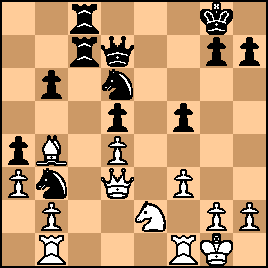
click for larger view24. Nc3
Missing the chance to try to go to town on the e-file with 24. Rfe1 or 24. Rfe1. After the text, Bernstein could have struck back with 24...Nc4! Instead, he embarked on a wild idea of (needlessly) sacrificing the exchange: 24... Rc4?
"Counter-attack." (Bernstein)
Indeed.
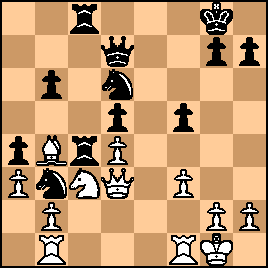
click for larger viewReshevsky now had excellent chances with 25. BxN QxB 26. Qxf5 Rd8 27. Rbd1 Nxd4 28. Qh5. But instead, he strangely played: 25. Rbd1?
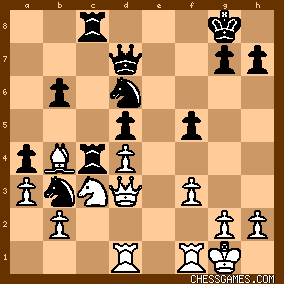
click for larger viewAnd here, Bernstein decided to try to land his misguided haymaker. |
|
Oct-21-23
 | | KEG: Post IV
25... RxB?!
This wild attempt to use terror tactics against the mighty Reshevsky must have seemed doomed to fail. Sammy was one of the most resilient players of all time and was unlikely to allow himself to be terrorized. The exchange sacrifice was entirely unnecessary since--contrary to what was claimed in Bernstein's commentary--Black would have been just fine after 25...Nb7 or 25...Rxd4, both of which would have yielded only a small plus for White. But, shocking to relate, Bernstein's efforts beginning with the text eventually led to his victory in this game. Bernstein perhaps put it best: "Black now makes a probably [I would delete the word "probably"--KEG] unsound sacrifice which has psychological value and results in extreme time-pressure for Reshevsky. Usually a great virtuoso in such situations, he loses his head completely in this instance." Incredible but true.
26. axR Nc4
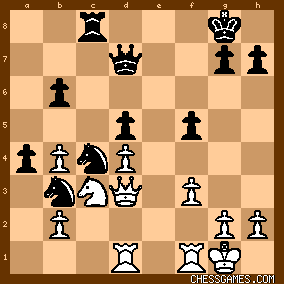
click for larger viewThe Black Knights do indeed look scary, but Reshevsky usually swatted away such problems where, as here he had a clear win. 27. Rf2 Re8?!
Still looking for the haymaker. Theoretically, 27...f4 was probably best, but Bernstein was going for the jugular. 28. Re2!
Nicely combining offense with defense.
28... f4?!
Another wild effort, but probably the only practical chance. It left the position as follows: 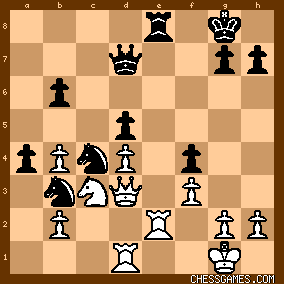
click for larger view29. b5?
As only <NM JRouselle> has apparently noticed, Reshevsky had a clear win here with the "crushing" 29. Nxd5! Although not as "crushing" as 29. Nxd5, White also seems to win handily with 29. Rde1 or 29. Rb1. The text, however, gave Bernstein a chance to survive: 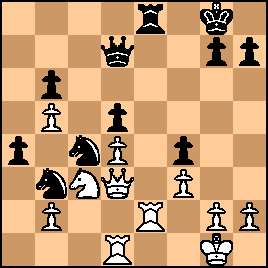
click for larger view29... Ne3?
Overlooking the best chance: 29...RxR 30. QxR [30. NxR? would lose on the spot to 30...Nxb2] Ne3. On this line, White would still be up the exchange, but Black's threats would have made winning extremely difficult. By contrast, Bernstein's 29...Ne3? and his follow-up wild move should have made Reshevsky's win easy. 30. Rde1

click for larger view30... Ra8?!
No half-measures for Bernstein. On the face of the position, the best chance (slim though it was) seemed to be 30...Qd6. But Sidney was going for broke. 31. Nxa4
31. g3 also wins.
31... RxN
32. QxN

click for larger viewNow Reshevsky just wins, right?
But, for once, Sammy succumbed to time pressure and Bernstein's tactics were about to pay dividends. On its face, of course, the position is a clear win for White. But that's not how it turned out! |
|
Oct-21-23
 | | KEG: Post V
32... Rxd4?!
No half measures such as the more restrained 32...Ra8 for Bernstein. At this point for Sidney it was no guts no glory. 33. g3!
This accurate move by Reshevsky seems to put an end to Bernstein's hopes: 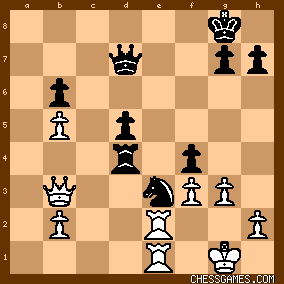
click for larger viewBut the clock was still ticking and Sammy hadn't made it to move 40 yet. 33... h6
Another defiant choice by Bernstein, creating a possible escape route for his King while keeping his desperation attack alive, all in lieu of something more cautious such as 33...Qd6, 34. gxf4
Why not!
34... Nf5
The only prayer of a chance---but in this case one that was about to be answered: 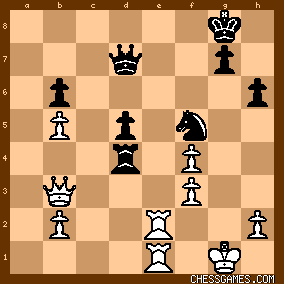
click for larger view35. Re5
"?"--(Bernstein)
"Allowing the enemy rook to penetrate to the seventh rank." (Bernstein) While less accurate than 35. Re4 (the fastest way to win), the text was most definitely NOT--as will be seen-- the losing move as Bernstein mistakenly believed. In fact, the text was superior to Bernstein's recommendation of 35. Re8+ which also wins but not as convincingly as should the text (let alone the best move, 35. Re4!)...Bernstein's analysis of 35. Re8+, as we will see, was flawed: 35...Kh7 [as Bernsteinr correctly pointed out, 35...Kf7? loses, but the clearest winning line was 36. R8e5 or 36. Qc3 rather than Bernstein's 36. Qa3 which, in fairness, also wins, though after 36...Kg6 Black has still has some play] 36. Qc2 [This does not blow the win, though 36. R8e5 is more convincing] 36...Rxf4? [very weak, 36...Rc4 would offer much better chances than Bernstein's lame choice; incidentally, 36...g6?? would get instantly crushed by 37. Qc6!] 37. R1e7 [This wins, but the clearest road to victory was 37. Rf8] 37...Qd6 [as Bernstein pointed out, 37...Qxb5 gets killed by 38. Rxg7+! KxR 39. Qc7+] 38. Re6 ["!"--Bernstein] 38...Qc5+ [awful move, though Black still loses after the "better" 38...Qb4] 39. QxQ bxQ etc. But the above analysis is all pretty much beside the point, since Reshevsky's actual move of 35. Re5 was more than adequate to win. 35... Rd2
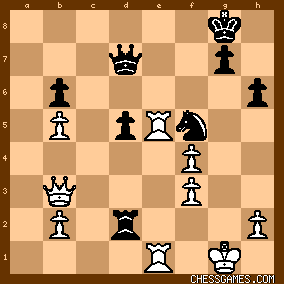
click for larger viewIt was in this position that Reshevsky made his losing blunder that--to quote <goser>--turned the position "from winning to lost" in just one move. Granted, the position is tricky with just seconds remaining to make five moves, but this was precisely the sort of situation in which Sammy usually shined. But such was not to be the case here. |
|
Oct-21-23
 | | KEG: Post VI
35. Rd1?
With one notable exception, everybody else (correctly) calls this the losing move: "...a real howler. He must have completely missed Black's ...Nd4." (<Count Wedgemore>). The one exception was Bernstein himself, who insisted that White was already lost. He reached this erroneous conclusion by missing the two available winning moves for White: (A) 36. Qc3 (see <goser>); or (B) 36. Re8+ (<Count Wedgemore>). In fairness to Reshevsky, all of us commentators on this site have had all the time in the world to examine the position plus the benefit of supersonic software to confirm our analyses rather than the seconds available to Reshevsky. On the other hand, Reshevsky--as so often--created this problem for himself. Though he usually handled such time pressure with ease, his habit caught up to him in this case and he committed a blunder we can be sure he would not have done with a tad more time on his clock. Reshevsky's dreadful 36. Rd1? left the position as follows: 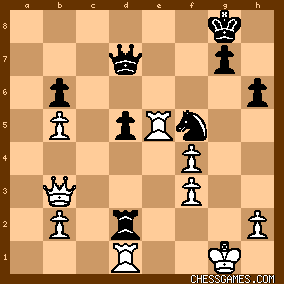
click for larger viewBlack to move and win. Not very hard to find when presented as a problem: 36... Nd4!
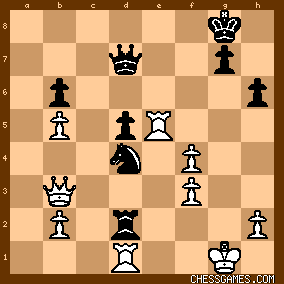
click for larger viewGame over!
37. Rxd5
Neither 37. Qxd5 QxQ 38. RxQ RxR+ nor 37. RxR NxQ 38. Rdxd5 Qc8 would have been much better. For once, Sammy found himself in a bind from which not even he could escape. After the text, the rest was easy for Bernstein: 37... RxR+
38. QxR QxR
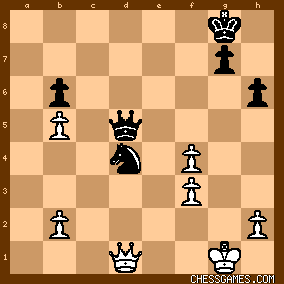
click for larger viewTwo pawns for a Knight in such an ending might sometimes provide hope of achieving a draw. But Reshevsky's remaining pawns were more than an eyesore. 39. Kg2 Qc5
40. Qe1 Qc2+
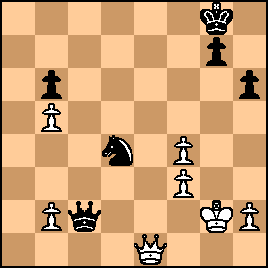
click for larger viewSo Reshevsky made it to move 40 without his flag falling. But now there was nothing much left to play for. 41. Kg3 Qxh2+!
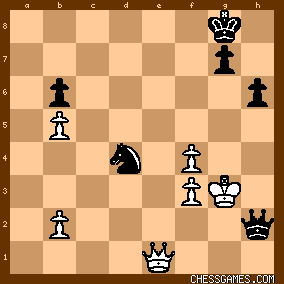
click for larger viewWith a potential nasty Knight fork in the offing, Reshevsky surrendered. 0-1 |
|
|
|
|





